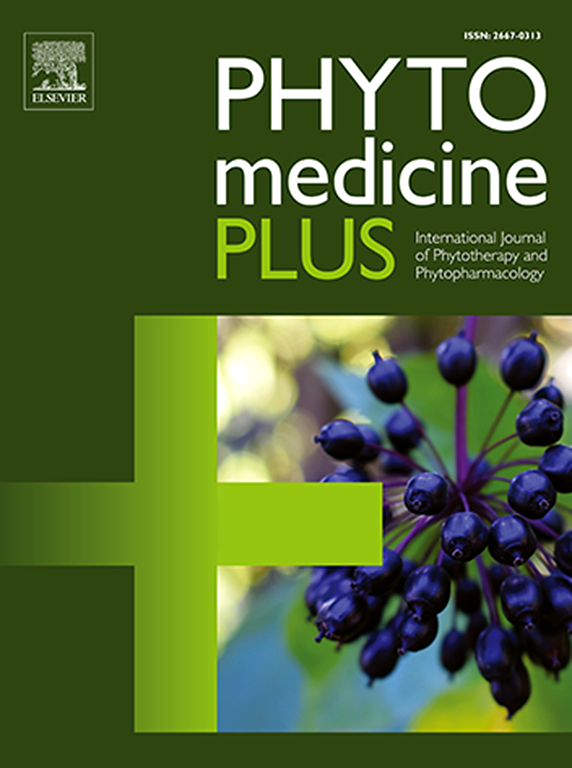巴贝芦荟和蒲公英锥虫原理的细胞学分析
Q3 Pharmacology, Toxicology and Pharmaceutics
引用次数: 0
摘要
在非洲的一些地区,使用草药治疗疾病是一种常见的做法,依赖于几代人发展起来的知识体系。这些草药疗法通常基于传闻,其中许多缺乏科学验证。本研究调查了两种生物活性组分F1 (IC50: 8.5µg/mL)和F5 (IC50: 7.4µg/mL)的作用方式,它们是从一种草药混合物的二氯甲烷提取物中提取出来的,该混合物由芦荟和蒲鲁英组成,在加纳通常用于治疗寄生虫热。两种组分均表现出杀锥虫作用,对哺乳动物细胞的细胞毒性最小。F5通过线粒体氧化应激诱导坏死细胞死亡,在2 × IC50时,线粒体活性氧增加3.5倍(p<;0.0001)和显著的线粒体膜去极化(p<;0.01)。相反,F1主要破坏着丝体分离,使2K1 N细胞在1 × IC50下增加3.2倍(p<;0.0001),并引发运动异常细胞(0KXN)的积累。这两种成分都引起形态扭曲、核碎裂和鞭毛完整性丧失。本研究提供了第一个机制的见解,从barbadensis和T. officinale混合物中获得的生物活性组分的抗锥虫活性。线粒体ROS生成(F5)和着丝体复制(F1)的独特靶向突出了它们作为开发具有新作用机制的新型抗锥虫药物的潜力。这些发现加强了民族药材作为新型生物活性化合物来源的价值。本文章由计算机程序翻译,如有差异,请以英文原文为准。

Cytological profiling of trypanocidal principles from Aloe barbadensis and Taraxacum officinale
The use of herbal medicines to treat ailments is a common practice in several regions in Africa, relying on knowledge systems that have evolved over several generations. These herbal remedies are often based on anecdotal claims, many of which lack scientific validation. This study investigates the mode of action of two bioactive fractions, F1 (IC50: 8.5 µg/mL) and F5 (IC50: 7.4 µg/mL), derived from a dichloromethane extract of a herbal mixture, consisting of Aloe barbadensis and Taraxacum officinale, that is commonly used in Ghana to treat parasitic fevers. Both fractions exhibited trypanocidal effects with minimal cytotoxicity to mammalian cells. F5 induced necrotic cell death through mitochondrial oxidative stress, evidenced by a 3.5-fold increase in mitochondrial reactive oxygen species at 2 × IC50 (p< 0.0001) and significant mitochondrial membrane depolarization (p< 0.01). In contrast, F1 primarily disrupted kinetoplast segregation, increasing 2K1 N cells by 3.2-fold at 1 × IC50 (p< 0.0001) and instigating an accumulation of dyskinetoplastic cells (0KXN). Both fractions induced morphological distortions, nuclear fragmentation, and loss of flagellar integrity. This study provides the first mechanistic insights into the antitrypanosomal activity of bioactive fractions obtained from a mixture of A. barbadensis and T. officinale. The distinct targeting of mitochondrial ROS production (F5) and kinetoplast replication (F1) highlights their potential as leads for the development of new antitrypanosomal drugs with novel mechanisms of action. These findings reinforce the value of ethnomedicinal plants as sources of novel bioactive compounds.
求助全文
通过发布文献求助,成功后即可免费获取论文全文。
去求助
来源期刊

Phytomedicine Plus
Medicine-Complementary and Alternative Medicine
CiteScore
3.70
自引率
0.00%
发文量
178
审稿时长
81 days
期刊介绍:
 求助内容:
求助内容: 应助结果提醒方式:
应助结果提醒方式:


